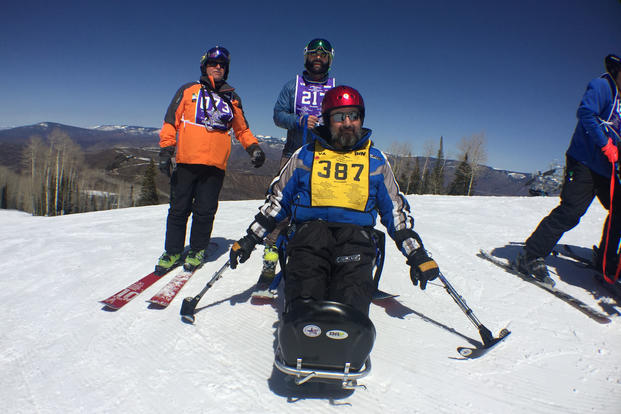If you think skiing down the snowy, tree-filled Rocky Mountains using just your arms, hips and torso seems to defy the realm of the possible, then it’s worth checking out the many small miracles taking place at the National Disabled Veterans Winter Sports Clinic, organized by Disabled American Veterans (DAV) and the Department of Veterans Affairs (VA).
Volunteer DAV ski instructor Alec Tossani has seen his share of small miracles at the clinic, and through hard work is doing his part to make the dream of taming the mountain a reality. He cites what originally inspired him to participate: the sight of a veteran who learned how to ski independently with a broken back.
“He was looking for things he could do. He had never skied before but was pretty athletic. He came out and went into a sit ski with two skis underneath it,” Tossani says.
The Winter Sports Clinic, an annual event in Aspen, Colorado, pairs hundreds of injured U.S. veterans with volunteer experts, coaches and guides in order to harness their resolve to embrace life without limitations, regardless of injury. The clinic includes scuba diving, snow-boarding, cross-country skiing and snowmobiling, among other activities; it is designed as a special opportunity for injured and disabled combat veterans to engage in high-level athletic activities.
Tossani is one of a number of volunteer instructors who have been inspired by veterans’ military service. He is a life-long ski enthusiast and former ski racer who works in Santa Fe, New Mexico as a software developer.
“We think it is an awesome thing to volunteer for,” he says.
Ski Tech
Many injured vets find a way to ski using both bi-skis and monoskis, systems especially designed to be used by those in wheelchairs or without typical limb-movement abilities. Tossani explains that a bi-ski resembles a chair with two skis underneath. Skiers use their body to balance, utilizing their hips, torsos and arms in some cases to navigate down the mountain. At times, skiers using bi-skis are tethered to an instructor for safety, while more advanced skiers ski autonomously.
“There are a couple of guys who are instructors but are themselves disabled," notes Tossani. "They ski in monoskis. They pretty much go down anything you put in front of them. This includes all kinds of moguls and the steepest stuff on the mountain."
Giving Back to Veterans
Veterans participating in the clinic have served in Iraq, Afghanistan and even Vietnam, and this year the roster even includes a World War II veteran in his nineties. Many are amputees, some have major bodily injuries, some have mental difficulties due to combat trauma, and some are dealing with a combination of these disabilities.
“It’s inspirational and fulfilling to give back to people who have served our country,” says Tossani. “You can’t get a better feeling than this. It’s so amazing to see the look on someone’s face when they realized they could ski when they thought that was something so far out of the realm of possibility.”
Tossani also enthusiastically recalls an instance when an injured veteran from the South held snow in his hand for the first time.
“His wife gives me a big hug every time they come because she is so happy with what the clinic has done for her husband,” he says.















